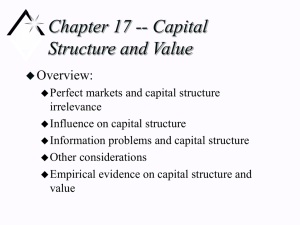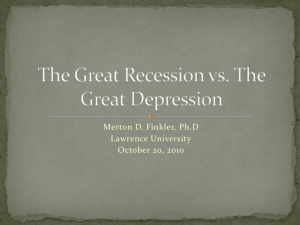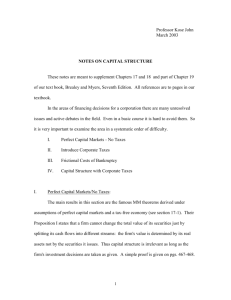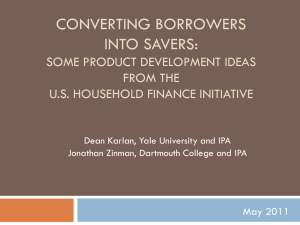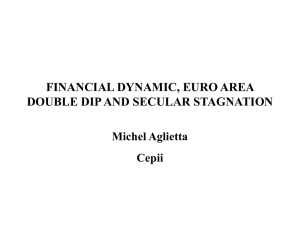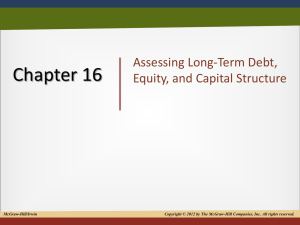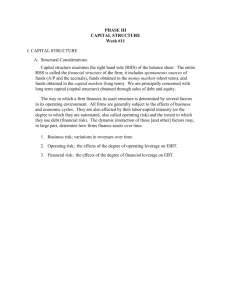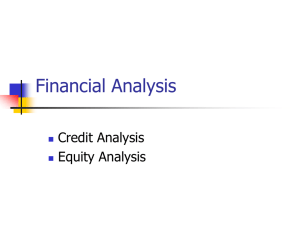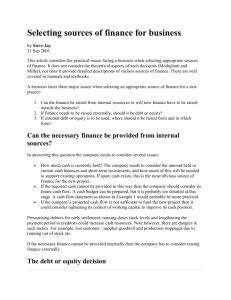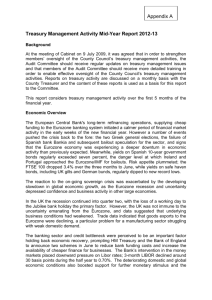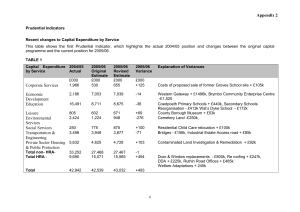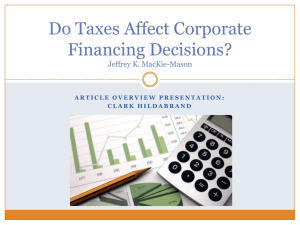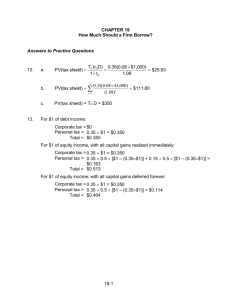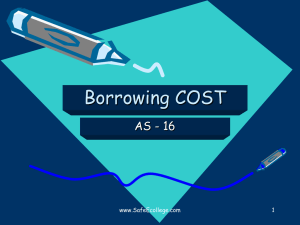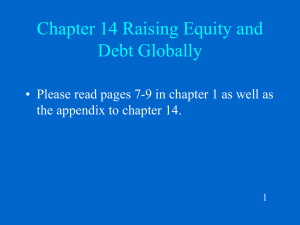Powerpoint
advertisement
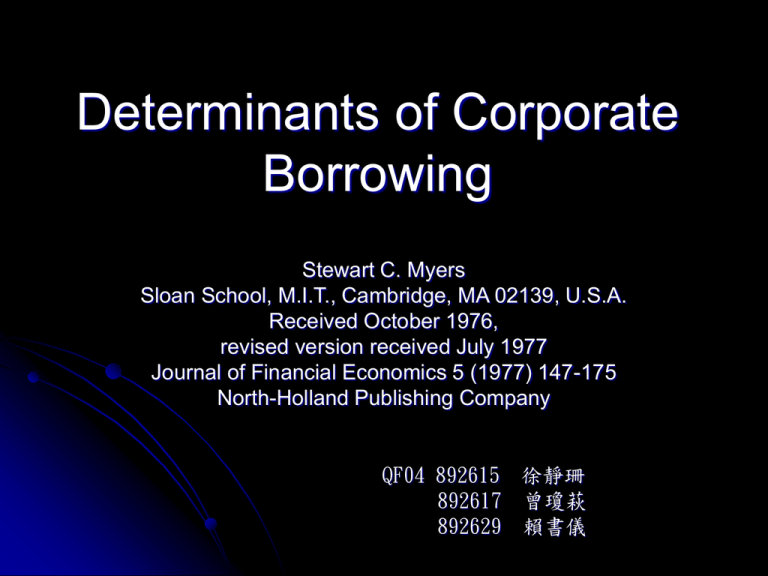
Determinants of Corporate Borrowing Stewart C. Myers Sloan School, M.I.T., Cambridge, MA 02139, U.S.A. Received October 1976, revised version received July 1977 Journal of Financial Economics 5 (1977) 147-175 North-Holland Publishing Company QF04 892615 徐靜珊 892617 曾瓊萩 892629 賴書儀 Summary Growth opportunity & call options Issuing risky debt & present market value Corporate borrowing & the proportion of market value accounted by real options Other aspects of corporate borrowing Introduction Borrowing -why not borrowing as much as possible -tradeoff between tax advantage of debt and costs of the suboptimal future investment strategy -other factors Assumptions Most firms are valued as going concern and the value reflects an expectation of continued future investment by the firm. The investment is discretionary. The amount invested depends on the net present values of opportunities as they arise in the future. V = VA + VG There are no corporate taxes and no bankruptcy costs. The firm’s managers act in the shareholders’ interest. Capital markets are perfect and complete Case1 A firm with no assets in place (VA =0 ) and only one future investment opportunity. The firm is initially all-equity financed. Balance sheet at t=0 Value of growth opportunity 0 VG Value of the firm V VE Value of debt Value of equity V If it decides to invest, additional shares must be issued to raise the required investment I. Balance sheet at t=1 Value of newly acquired asset V (s) 0 Value of debt VE Value of equity Value of the firm V (s) V(s) Case2 The debt matures before the investment decision is made, but after the true state of nature is revealed. Balance sheet at t=0 Value of growth opportunity VD Value of debt VE Value of equity VG Value of the firm V V The firm raise the amount I and exercises its investment option. Balance sheet at t=1, given x (s) =1 Value of newly acquired asset V (s) Min[V(s),P] Value of debt Max[0,V(s)-P] Value of equity Value of the firm V (s) V(s) There is a definite limit, VD (max) If the option exercised, min (V (s) ,P)=P V is a monotonically decreasing function of P Trade-off Assets as call options Bankruptcy cost ˙renegotiating the debt contract 1. Incentive: If bondholders and shareholders find themselves in the position where V<P, then it is in both interest to renegotiate. 2. Disadvantages: ‧the direct costs of renegotiation ‧a costly duplication-it is doubtful that bondholders could obtain an adequate estimate of V without continual monitoring of the firm’s actions. Liquidation cost & reorganization cost ˙rewriting the contract There would rarely be any objective basis for judging whether the contract is breached, for example, V(s) which is not objectively observed. Impaired ability to conduct business ˙mediation 1. incentive : When there are symptoms of financial distress and suspicion, bondholders would call for an impartial party to mediate. 2. disadvantage : It is difficult to define when the mediator to be called in. Agency cost *case 1: shareholders may take a risk investment ˙Honesty is the best policy 1.Cause and effect: Stockholders can play at the short-run expense of bondholders, but in the long run, shareholders bear the costs. 2.Voluntary forbearance is the simplest and best solution to the investment incentive problem. *Case2: Shareholders may reject an investment with positive NPV. ˙Honesty is the best policy *case 3: Shareholders may pay excess dividend. ˙Restrictions on dividends Imperfections in Real Asset Markets We think of the firm as composed of two assets type: real assets, real option. And we assume the market is not perfect and complete. Here, it is necessary that the value of a growth option vanishes if it is not exercised by the firm. Case 1: if the real option is firm-specific Case 2: if the real option is not firm-specific Long-term borrowing Assume a firm holding options wants to exercise one of its option, at the same time, it has bonds outstanding which is mature at t : Vt VE ,t VD ,t : the value of the firm dVE dV dVD dI dI dI : an incremental investment on the market value of equity dV 1 : the investment policy continues dI investing. The value of the firm’s debt : VD,t ft Vt , 2 V t 1 / Vt Therefore: There is a transfer cost of value from stockholders to bondholder: dVE ,t dV dI dI ft 1 Vt ft t2 2 I t t dVt dVE ,t dV ft ft t2 Zt 2 dI dI dI Vt t I t if Zt 0 , the investment exist. Assume t 0 ,what happened? 2 t Fig 4. Spillover Effects & Shift in Asset Risk Spillover effects: In brief, the investment at t will affect the value of the firm at t-1 and t+1. Shift in asset risk means that each investment of the firm may face different risk. the impact of risky debt on the market value of the firm is less for firms holding investment options. In this sense we may observe risky firms borrowing more than safe ones. borrowing against a portfolio of assets One advantage of corporate diversification is that diversified firms can borrow more. We take two firms i, j holding two real options. First, we take a numerical example: case A: Vi(s)+Vj(s)>Pi+Pj, it will be taken. case B: Vi(s)+Vj(s)<Pi+Pj, it will not be taken. Vi j Vi s V j s Pi Pj : the point to justify investing or not. Vi j : the present value of option i in portfolio with the other option j DVi Vi j Vi s : diversification value case Conclusions This paper is presented: The firm’s growth opportunities could be views as call option. If the firm want to issue debt, what is the place to borrow? We think that it’s case by case. Until now, we introduce many situations. Each has different a way doing. The author thought that he’s still have many things didn’t present yet.
